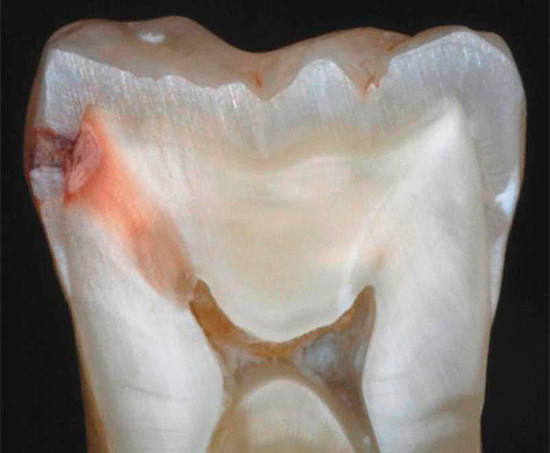
The term "internal caries" ordinary patient dental clinic usually understands the disease, affecting tissue deep under the tooth enamel. At the same time, doctors know that by and large, any caries affects exactly the internal tissues of the tooth, which are softer and more easily damaged than enamel. Therefore, the phrase "inner caries" can be applied to almost any case of the disease and by and large is a tautology.
In some cases, internal caries is said to mean the pathological process under a crown or a poorly fixed filling. Here the caries inside the tooth develops completely unnoticed both for the doctor and the patient, and only shows itself when the enamel is covered by a pathological process around the filling (crowns) or when pain occurs. But again, this is all the same ordinary caries, just with non-standard localization.
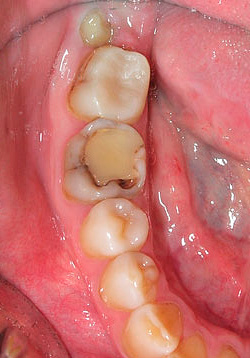
However, the reasons diagnosis and treatment of caries inside the tooth have their own specifics.
Signs and appearance of teeth with deep caries
In the photo below - internal caries on the tissue under the destroyed enamel. This is a typical type of disease developing inside a tooth. Dark areas of the affected dentin are clearly visible:
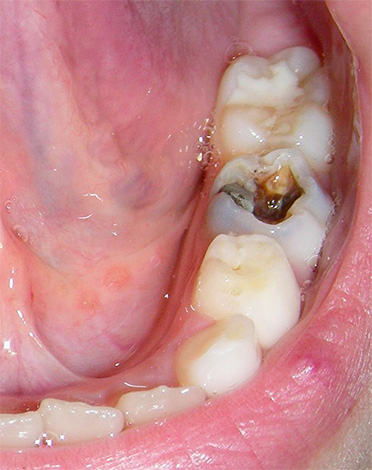
It is the changed color of tissues damaged by caries that is the main diagnostic sign of the disease. In the overwhelming majority of cases, the doctor unequivocally makes the diagnosis "caries" precisely by the black points on the enamel or on the fissures.
From the practice of the dentist
Black dots on the teeth may indicate either congenital or acquired (most often) pigmentation (“smoker’s bloom”, etc.), but more often - on hidden caries. When you begin to drill such points, they go so deep that 70-80% of the points within the enamel are completely removed, and 20-30% reach the dentin, and sensitivity appears (if the patient, due to the refusal of anesthesia, asked to manipulate the conditions until it becomes painful). Since the patient is always right, we act according to the situation: it becomes painful - we will coordinate and administer anesthesia according to the protocol to the brave client.
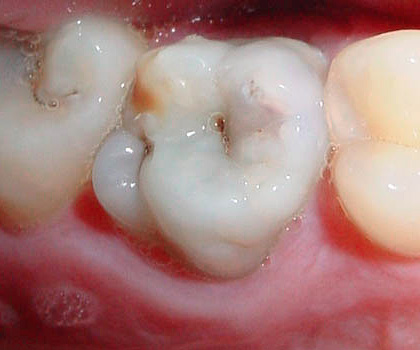
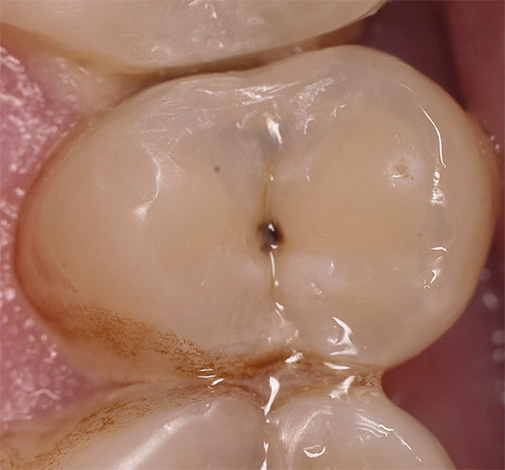
Sometimes even seriously damaged teeth with internal caries can seem perfectly healthy. So, if the surface from which the damage began, fits snugly to the other tooth, caries can develop deep in the internal tissues, and even with a close examination of the oral cavity with the naked eye goes unnoticed. The situation is similar when the caries inside the tooth develops from damage in the enamel located below the soft tissues of the gums (root caries).
In most cases, at the first inspection of the teeth, their walls (surfaces) affected by caries are striking. These are often not carious cavities, but simply gray, dull enamel, which has lost its healthy appearance due to demineralization.
Often, the dentist sees a certain “tunnel” in the gap between the teeth, but the probe may, due to the density of the interdental gap, not pass into the hidden internal carious cavity. Usually, the doctor shows the patient the grayish shades of enamel against the background of the developed internal caries in the mirror and, after anesthesia, starts the treatment of the tooth.

When boron touches gray enamel, in almost 90% of cases, after a couple of seconds, it breaks off and boron falls into the innercavity with an abundance of carious, pigmented, infected and softened dentin. If the anesthesia is performed by the doctor correctly, there is absolutely no pain.
The doctor performs cleaning and filling of the tooth strictly according to the caries treatment protocol. If there is already a message in the tooth with the pulp chamber (the cavity where the nerve is located), then the doctor will depulpate and fill the canals with the subsequent production of permanent fillings in one or two visits.
The photo below shows a tooth in which deep internal carious cavities are visible under bright light:

The following photo shows fissure caries, that is, localized in the area of the natural relief of the teeth. Under such darkening inside are also often hiding significantly destroyed tissue, which is not immediately detectable during a routine inspection:
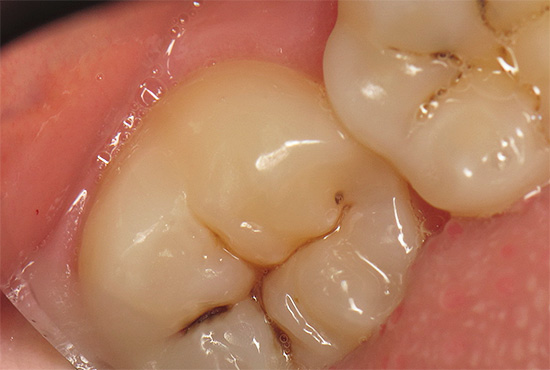
At home, such an "internal caries" is almost impossible to detect. He will present himself only in case of extensive damage to the dentin and pain in the tooth when the pulp is turned on in the pathological process. That is why preventive visits to the dentist are so important,which by special methods can detect caries at any of its localization and cure a tooth before its depulpation (nerve removal) is required.
Causes of deep caries
The causes of caries in deeply located tooth tissues are similar to those for caries with any other types of its localization. The disease develops due to the following factors:
- The constant presence in the oral cavity of acids, as trapped here with food (fruits, vegetables), and produced by bacteria that consume the remnants of almost any carbohydrate food - flour, sweets, cereals.
- Reduced secretion of saliva or its low bactericidal activity. This may be caused by other diseases or metabolic disorders.
- Mechanical and thermal damage to tooth enamel.
- Hereditary factors.
Caries usually develops under the influence of a complex of several such factors.

In any case, it is in the deep, under the enamel parts of the tooth that caries develops most quickly due to the greater susceptibility of the tissues to the action of acids. Therefore, there are often situations where a barely visible (and even generally invisible to the naked eye) opening is an extensive cavity destroyed by the carious process.
On a note:
That is why the enamel is almost always broken off (coming off in a piece) when a large carious cavity has already formed that affects the layers of softened infected dentin. That is, the enamel can hold the load for a long time, hanging over the hidden carious cavity, often without giving it away.
Features of diagnosis of caries inside the tooth
It is much more difficult to diagnose caries inside a tooth than usual ones, which have manifestations on the enamel surface. Definitely it can be noticed when using the following diagnostic methods:
- Visual examination, in which the doctor may notice cavities darkening under the enamel.
- The use of caries markers - special brightly colored liquids that linger on surfaces damaged by caries. When internal caries with their help determine the boundaries of damaged tissue after the opening of the enamel. In dental practice, 2% methylene blue or fuchsin-based preparations are usually used.
- X-rays, at which deep cavities affected by caries, have a significantly darker color.

- Transillumination (transmission of a tooth with a bright light) and luminescent diagnostics (the same, but with the use of ultraviolet light).With such screening, the internal lesions of the tooth become clearly visible.
- Laser diagnostics is a method by which a laser beam is sent to a tooth, which initiates its own luminescence of a tooth. The tissues affected by caries emit light in a range that is different from that in healthy areas. This is recorded by the device, which beeps and displays the results graphically on a computer screen.
In addition, neglected internal caries causes pains in the patient, at first not strong and occurring mainly when chewing hard food and contact with the tooth of very cold products, and aggravated as the disease progresses. If a tooth starts to regularly hurt without visible damage, you should definitely come to the dentist for a checkup.
The following methods can be used as auxiliary for diagnosing and confirming caries inside the tooth:
- Fissurotomy - minimal opening of the enamel over the (presumably) carious cavity with the help of special thin burs. It is usually not carried out to confirm the diagnosis, and to clarify the boundaries of the carious area.

- EOM - electroplating.When it is, a tooth is affected by weak currents to determine the threshold of its sensitivity. This allows us to distinguish internal caries from pulpitis.
Disease Treatment Rules
In all cases of caries development inside the tooth, its treatment requires the opening of enamel, the removal of the affected dentin and the filling of the cleaned cavities. In its advanced form, internal caries leads to the need to remove the nerve and fill the canals.
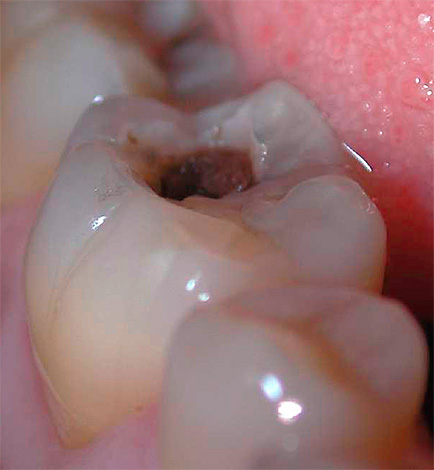
Even more difficult are situations when a very large amount of tissue is damaged by caries from inside the tooth, and it either splits after its removal or simply due to softening. In this situation, according to indications, it is often necessary to remove a tooth with the subsequent installation of an implant at the request of the patient, or to manage with modern prosthetic techniques.
On a note
A split split is different, so tooth-preserving techniques may include, for example, restoration of a tooth on a titanium (anchor, fiberglass) pin after its thorough intracanal treatment + installation of a crown (metal ceramics, stamped, solid-molded, etc.) may involve preparing the tooth under the tab, setting tabs + crowns.There may be many options.
Sometimes the damage is quite extensive, but they manage to preserve the roots of the tooth, removing the pulp from them. In such cases, it is possible to manage installation of the crown.
In any case, after the detection of the carious cavity, the doctor carries out its cleaning with boron. If such tissues come close to the pulp, their removal can be painful and is most often performed using local anesthesia.
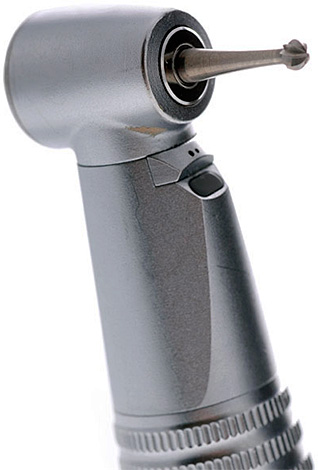
From dental practice
There are ambiguous situations when the pulp area is not opened yet during the cleaning of the carious cavity, but the patient begins to feel pain when the doctor is working. Definitely it is not possible to say whether it is necessary to carry out a depulpation here or not. Without depulpation after installing the seal, it can start to disturb the nerve endings when chewing and cause pain. Some doctors tend to depulp such a tooth so that it does not have to perform repeated work if the patient begins to experience pain after installing the seal. Other dentists explain the situation to the patient in detail and make a decision with him. It should be borne in mind that many patients are very sensitive to the preservation of their teeth in a "live" form and are willing to take a chance,in order to walk a few more years with a tooth with preserved pulp, if after a simple filling the pain will not arise.
In general, even with deep caries, it is necessary to remove the nerve, according to statistics, in less than a third of the cases, and the removal of the tooth itself due to deeply penetrated caries is generally a rather rare situation.
Prevention of deep caries
To avoid the development of caries deep inside the tooth can, if you regularly undergo preventive examinations at the dentist and detect the appearance of the disease at the stage of the stain. With this approach, with a high degree of probability it will be possible to avoid depulpation, and in the absence of hidden caries, it will even be possible to do without opening a tooth and filling it.
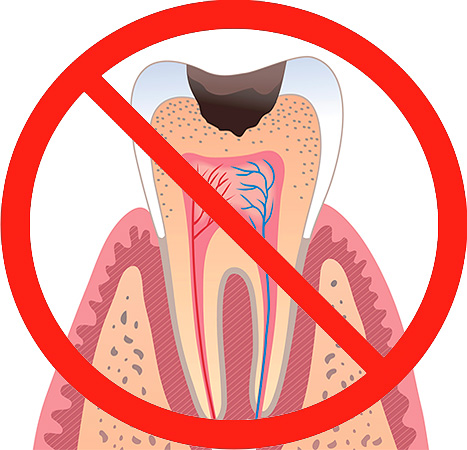
To prevent the appearance of even the earliest signs of caries, the following preventive measures should be observed:
- brush your teeth thoroughly at least twice a day - after breakfast and before bedtime;
- after eating, rinse your mouth;
- do not get involved in sweets and sweets;
- remove leftover food stuck between teeth;
- Avoid getting too hot or too cold foods and drinks on the teeth.
If you are susceptible to carious damage to your teeth, you should consult with your doctor and, according to his recommendation, take calcium and fluoride preparations in the form of tablets or special solutions.
Chewing gum containing xylitol instead of sugar can be an additional preventive measure. They should be chewed for 10–15 minutes after a meal to enhance the production of saliva and clean the gaps between the teeth.
In combination with systematic use, such preventive measures will provide reliable protection against damage to the teeth, and even when the first signs of caries appear, the doctor can manage to eliminate the pathology before it spreads to the deep tissues under the enamel.
Interesting video: preparation and restoration of the tooth with deep caries
An example of a two-step treatment for deep caries

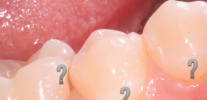
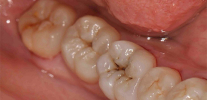
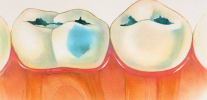
Well, tin with this caries.
How to treat?
Nightmare. I'm afraid to go to the dentist. Already four teeth fall apart.
After birth, my teeth began to darken, and now two teeth fall apart. Terribly afraid to go to the dentist.
Now you can be treated under sedation, it is not particularly harmful. After taking the drug to the vein, you will almost fall asleep like a baby ... If it is a very painful procedure, then don’t even remember what happened. And if you just put a seal, you will be in a very relaxed state, completely without fear. And for anesthesia, you will be given an ordinary injection in the gum.
Oh, what a horror this caries! Brrr ...
I have problems with my teeth, but I will still go to the dentist, especially since I have found a good clinic. This is better than losing teeth.
It’s scary when you don’t even know about it, and then you go to a doctor, and 70% of your tooth has rotted inside you. And why be afraid? After anesthesia, there are no sensations at all. Even when a metal pin is inserted into the root.
I am very afraid to go to the dentist, almost the entire tooth is eaten by caries. I do not know what to do, but I will not go to the dentist anyway.
Hello Maria! This is not the most sensible decision, because a tooth destroyed by caries may, sooner or later, start causing severe pain, and often - cause a "flux." At my reception people often regret that they didn’t come in time, because it is much easier to treat a tooth when there is no edema near it. Of course, now everything is done with anesthesia, the procedures are painless. Therefore, your fears are in vain, there are much more good doctors than you think.
Unfortunately, not for all painless. Even with a shot of ultracain, it is painful for me to treat simple caries. I am terrified of what happens when a nerve is removed.I remember a moment from my childhood when I was removed to live, without an injection, and the arsenic didn’t work at all. And since the freezing is bad for me, it turns out that it will be unpleasant to remove the pulp with the injection. Hence the fears.
And I rather fear that I will not have enough money for quality treatment! ))
Wine in most cases in late treatment? This is how you explain the situation that every six months I went for a check-up to the dentist, asked to pay attention to the dark stain of the tooth, asked if it was necessary to treat it? What they said to me - no, everything is fine, nothing suspicious, like this stain is pigmented ... And, oh, a miracle! 9 months after the first examination, the doctor states that this tooth should be treated and there, probably, deep caries. Paul tooth broke me! And so every doctor doesn’t know whether they have a pigment spot or caries until you force them to pay attention to the problem. As for me, any black spot is a caries, and no pigmentary spots!
Hello! I will say this: a dentist in a public institution is often not set up to analyze spots on the subject,whether it is pigmented or not (there is little time for one patient, no equipment, low motivation, etc.). Secondly, in many private clinics you will be drilled spots of any origin, no matter whether carious or not, how many they will be and how many teeth will be necessary for this work (the more, the better). Moreover, more than half of this will turn out to be pigmented spots, but for prophylaxis (so that nothing will work out and for greater advantage) they will be sent for treatment. Only the patient will be sure that caries was on all teeth.
Third, the staining procedure itself to determine caries takes considerable time and requires a separate group of specialists in general - hygienists. They prepared these specialists specifically for professional work, but most of them turned out to be released and not needed: they did not take a job, they needed a crust of a dentist, a dentist-therapist, a surgeon, an orthopedist, etc., but not a job - to retrain these urgently. If there is no prophylactic trend in the country, then why budget specialists will begin to disassemble, tooth decay or not, if: 1) they often do not pay for it or pay a penny; 2) the doctor and so much work with already formed caries and its complications.
And private owners, on the contrary, are ready to cure even pigmented plaque, like caries. How many have complained to them - do not count. And in conclusion, I would say that a black spot may well be a caries, but pigmentation, a “smoker's” bloom (conditional name), fluorosis, tartar, chemical enamel necrosis, etc. can also occur.
Will they drill a tooth with a very small hole?
Hello! You are talking about a fairly pronounced violation of the integrity of the enamel, so the ICON technique (that is, the treatment of a tooth without “drilling”) will not work in this case, as it is used for carious stains, when the enamel has not yet collapsed. Accordingly, only the preparation of the drill is appropriate in this case. But one should not be afraid of this procedure, since the treatment of enamel with boron is carried out only a few minutes, under anesthesia and with the important goal: to rid the tooth of carious tissues dotted with bacteria that dissolve it. So look for a good dentist and a good reception for you!
My fifth tooth decayed, launched, from childhood fear of dental treatment. The tooth does not hurt. Got the courage, went to a paid clinic.The dentist-therapist, looking at the snapshot of the tooth, said that it would be possible to do something. And the orthopedic doctor, having looked at the tooth and poked it with a piece of iron (I apologize, I write more simply, without sarcasm), said that the tissues are soft, it is better to remove them, because they will just waste money (treatment, pin, etc.). I believed him, because when poking, I felt that the tooth was soft as if. Now I think ... Go immediately to surrender, delete, or, maybe, somehow save. Question: can I do something? And more ... For those who are afraid, shy and pulls with rotting teeth. Do not tighten, go at least for a consultation, and it will be easier for you. As the dentist told me, "caries does not go away by itself."
Hello! I am afraid that you are faced with the situation when it comes to the so-called "controversial tooth." Unfortunately, it so happens that the opinions of a number of specialists on the same occasion can be significantly divided. You can consult with another 2-3 dentists in different clinics (the good is that it is almost always free of charge if it is primary) and understand which point of view prevails.
Without seeing the condition of your tooth, it is impossible to make a verdict in absentia only by description only, although the problem is clear in general.In fact, every year in Russia tens of thousands of teeth are removed, which could be preserved, and about the same remain without prospects for long-term existence. These are the realities of life - it is not always possible to “stick” the indications to a particular action (to heal or remove) for various reasons, ranging from the patient’s strong desire to remove a tooth with even a small caries or pulpitis and ending with a lack of desire in the dentist or equipment (materials) for tooth salvation.
I can say for sure that if a dentist-therapist and an orthopedist work in the same clinic, it’s not worthwhile to push them together with “foreheads”. It is better to contact a couple of other clinics and form a general idea. A large number of votes for tooth extraction will convince you without any special worries (and regrets in the future) to get rid of it, and dentists will tell you that the best on the "price-quality" criterion is suitable for its replacement. With a minority of votes, you will know how best to save a tooth so that it continues to serve for many years.
From my personal experience. I had a dentist ... I don't even remember when. Yes, yes, it was the same FEAR.Despite the fact that I saw with my naked eye and with my mind I understood that I ruthlessly start my teeth. Once the tooth wall broke off and I had to make an appointment. For the first time, the whole body and voice shook with fear, the heart almost jumped out of the chest. The result - 14 teeth with caries were found, one tooth that had a wall broken off had to be removed, since there was nothing to save. And a lot of money spent and nerves, and the devil knows how much more to spend. But dental treatment is completely painless. Hear? PAINLESS. Now, in the fourth decade, I understand how wrong I did, bypassing dentists over a thousand kilometers. Now there is no fear, calmly and comfortably sit in a chair and worry only about being able to save what is. Now there is only one fear - at least enough money for treatment. Just kidding I have been treating for the third month already, carefully collecting receipts in order to issue a tax deduction in the future ... And all this could have been avoided if I went to the doctor many years ago ... But alas, this is no longer possible. So go through the first fear. Make sure that there is no pain at all, and then, believe me, it is already much easier, and the dentist becomes more dear to everyone in the world.Good luck.
Alas, all different. Local anesthesia hardly works on me. Well, except that after the 10th injection, and then from these injections for two weeks, the whole mouth will be swollen.
My tooth is rotten, the pain is terrible, around the swelling down ...
Hello! Apparently, in your case we are talking about a purulent process that can characterize acute periodontitis, periostitis, abscesses, etc. If there are indications for tooth extraction, it is urgent to remove it in order to avoid further advancement of the infection in the maxillofacial spaces (otherwise the situation may worsen significantly, up to sepsis - blood infection). If we are talking about periodontitis, then the tooth is often saved. It is important to consult a doctor in time and make a diagnosis in order to remove the source of purulent infection in a timely manner: this often does not mean tooth extraction at all, but it is a matter of step-by-step treatment of tooth canals followed by filling and restoration with a filling, or a tab or crown.
Hello, two months ago I re-installed a seal in a paid clinic, my nerves were removed a long time ago.The doctor put me a seal, and when he did this (by the way, he cleaned the canals and put a seal without anesthesia, he decided so), it felt as if he had put something that expanded my tooth, and then tried to squeeze it. I was so scared that I jumped on the chair. At home, she found that the tooth was cracked - slightly, but along the entire length. A week later, the smell and taste of rot appeared. With this tooth I was afraid to eat. After another two weeks, a piece of tooth fell off, and sometimes in the morning it hurts, sometimes there were severe pains at night. And so, I'm still going to snatch him. Just did not understand why it happened ...
I have a bad situation with all my teeth, although I clean it twice a day, and rinse after eating, remove the pieces. Caries on all lower teeth, somewhere in the whole teeth hollow outside (I'm 20).
Hello! Judging by the description, the complication was most likely due to the fact that the doctor violated the rules for the restoration of the tooth. Or did not take into account the indications for his recovery - it was possible that orthopedic treatment was required, rather than a filling.
Regarding the progressive destruction of teeth by caries at the age of 20: as you understand, plaque plays a key role in the development of the carious process.Accordingly, you do not brush your teeth on all surfaces. Very often, the teeth begin to break down first in the cervical area where plaque accumulates, especially on the contact surfaces (between the teeth), when a lot of food gets into the gaps between the teeth, and it remains there, "rotting." It also affects the chewing surfaces of the teeth, where there are pits on the teeth (fissures), from where food is difficult to clean.
It is not so difficult to clean the interdental spaces: dental floss or irrigator to help you. The caries that have already been formed will not disappear from good hygiene - the treatment of these teeth is required, and the sooner the better. But the prevention of caries on the still healthy teeth is important to hold. I recommend to get an internal consultation of the dentist about this - it is possible that in your case there are additional prerequisites for the rapid destruction of teeth by caries.
And I would advise one thing - to completely stop eating sugar. Only this helped me in my time. And the brushing of teeth was pretty little, honestly.
I recently sealed my tooth (a month ago), yesterday, by chance, I discovered a black vertical crack on the side.Should I go again to treat the same tooth? And why then the doctor did not do anything with it?
Hello! The fact is that some dentists sometimes either ignore small pigmentation, which can only theoretically be a carious stain, or simply do not notice problem areas in the course of work due to carelessness.
Since according to your description it is not clear what is a “black vertical crack” and how dangerous it is for a tooth, I recommend to go to the dentist again (better to another doctor). And already then purposefully to find out whether it is worth making any intervention.
Yes, as these doctors were Konovalov, and stayed! Today, thanks to them, I lost another tooth, and I just broke off with the light-cured filling! Moreover, the quality of the light-cured material is high, it didn’t even stoop for about 7-10 years of standing in the tooth. Immediately clear - bourgeois, not our "flippers" made. But, damn, our doctor 7 years ago (I don’t remember exactly, maybe all ten have passed) when installing this seal, I just stupidly badly cleaned my tooth from caries! And here's the result - during these 7-10 years, the tooth slowly rotted from the inside, without pain and imperceptibly.And as a result, I broke off together with a superclass filling - and now I lost my next tooth because of our fool doctors (well, or little fools)! And I never regretted money for dental treatment and always went to paid doctors. Recently, I looked at my mouth in the mirror and saw that practically all of my filled teeth have darkish stains - and this, their mother, these doctors, means that they all, with a few exceptions, poorly cleaned the dental cavity before installing fillings!
Hello! If we are talking about darkening on the "living" teeth, then yes, the carious process can develop under the insufficiently established filling.
Plus, there is still such a moment (more common): after depulping, the tooth itself can darken + becomes fragile, since its tissues no longer receive nourishment. That is why the best way to work with pulpy teeth that have thin walls is the restoration using the tab + crown, and not filling with photopolymers, even with pins. Let it be a more expensive option, but with a high-quality manipulation of the technical part, the tooth can be maintained for 15 or more years.
Good day! Dark stripes on the teeth - should they be treated, or is it the “whim of the patient”? The doctor did not say anything ... I treated two teeth, he said that there are no more holes))
Hello! If it is caries, then you definitely need to treat your teeth. If pigmentation or non-carious lesion, then decide at your discretion, since the solution (or not the solution) of aesthetics questions largely depends on the person himself. Refer to another dentist, and to know for sure, you can get 2-3 independent opinions that will give additional confidence in further actions.
Hello, I am 11 years old. It hurts a tooth, I decided to read. In the evening, the tooth hurts not so much. So, honored and scared now go to the dentist. But I don't want to lose my teeth.
Hello! Today, almost all procedures are performed with anesthesia. That is, the treatment in most dentists is painless. The only difficulty is to find a good dentist with high-quality equipment. But the best way is to contact a doctor who is approached by your relatives, friends and acquaintances who are satisfied with his work.In this way, you can find your dentist, make friends with him, as you will have to regularly apply for a long life with different situations - this will help keep your teeth until old age. I recommend this to be done as soon as possible, since at your age almost always the teeth are all permanent, and with regular pain it can be a question of complication of caries, which is often one of the reasons for tooth extraction.
In some clinics they do this procedure - you inhale a certain amount of "laughing gas" through the mask before treatment, and you feel so good and calm that you will not be afraid of anything. The main thing, of course, is that you do not have contraindications, but this is decided by the doctor after the examination, based on the state of health and the presence of some other diseases.
Hello, and what means can kill bacteria causing caries? I, for example, rinse my mouth with water with salt or soda, or hydrogen peroxide diluted in water, or furatsilinom. What I polished my mouth, does it kill bacteria or not?
Hello! These methods are practically ineffective, as it is scientifically proven that caries occurs under dental plaque, which requires mechanical cleaning. Antiseptics can partially suppress the activity of bacteria in the oral cavity, but under a dense plaque to destroy all the bacteria will not succeed. Plaque needs to be “moved” with a toothbrush, and the contact surfaces of the teeth require special care: the use of dental floss or irrigators. Hydrogen peroxide is an aggressive tool and is only for professional use, as if used improperly it can cause burns of the mucous membrane.
To ensure truly effective prevention of caries, you should first contact your dentist and carry out professional oral hygiene (cleaning of stone and dental plaque), and then at home maintain a high level of hygiene with a toothbrush and toothpaste, which the dentist will select existing problems. If with gums, then to relieve the inflammatory process of the gums; if with carious lesions, then after treatment of caries - therapeutic and prophylactic with fluorine; if sensitive teeth orthere is abrasion of enamel - paste, with a reduced content of abrasives ("for sensitive teeth"). And what you rinse your mouth, partially suppresses the microflora, but it often harms more than helps to solve problems.
I flew a seal, and under the seal all black. And the tooth wall staggers, but there is no pain. On some sides there are black dots on one side and in large quantities. What to do with it?
Hello! With a high degree of probability under the seal recurrence of caries, that is, there are carious tissues. Almost always, the wall breaks off due to the fact that the tooth is "dead" and has a strong carious destruction. If the tooth was previously pulped, then a snapshot is needed to diagnose a possible inflammatory process and the quality of canal filling. If the tooth is “alive”, it is often enough to check the degree of tooth decay to decide whether to remove the “nerve” or not. Often the doctor is inclined to remove the nerve, and since you have already been treated for caries, it may not be possible to put a filling a second time without root canal treatment.
On the remaining teeth, I am almost sure that there are also carious lesions, since the black dots about which you write usually indicate exactly this (much less often - pigmentary spots).I am sure that you need urgent treatment of caries, but only a doctor will determine the treatment tactics after carrying out diagnostic measures.
Good day. Wanted to ask, is ultracarine really that good?
Hello Victor! Ultracain in dentistry is used for a variety of procedures, including during surgery (the drug does have a high level of anesthesia due to its composition). However, no matter how safe this anesthetic is, compared to its analogues, it still has its own contraindications. Therefore, if you have an intolerance to some drugs - you should definitely notify your doctor in advance.
Hello. A tooth collapsed with a filling, darkened in a month. Now the tooth began to ache and the gum ached. The tooth has two sides destroyed, the third one has also begun the process of destruction. The fact is that I am 9 months pregnant. I do not know what to do…